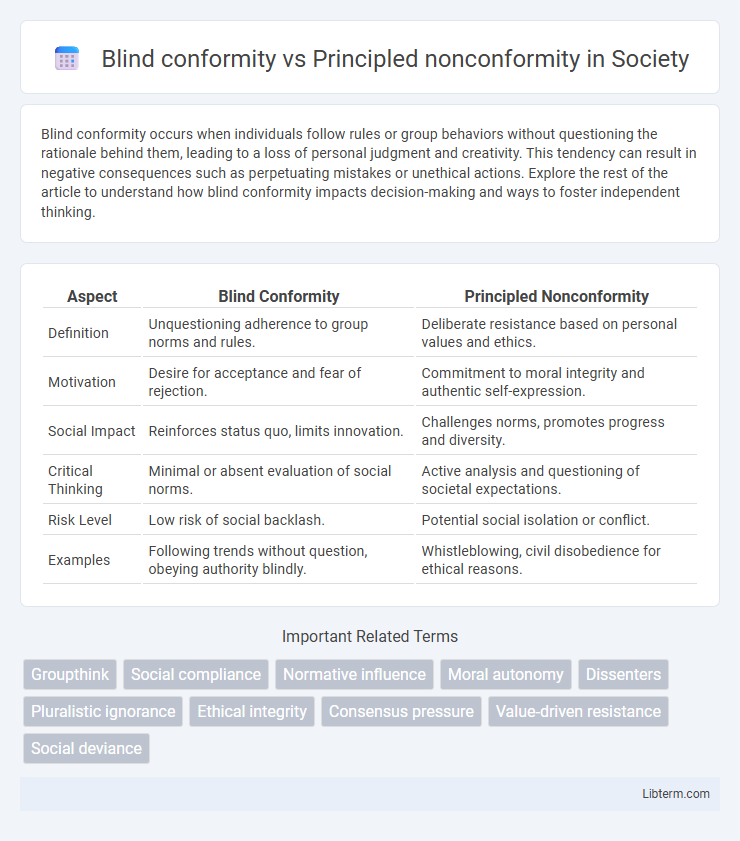Blind conformity occurs when individuals follow rules or group behaviors without questioning the rationale behind them, leading to a loss of personal judgment and creativity. This tendency can result in negative consequences such as perpetuating mistakes or unethical actions. Explore the rest of the article to understand how blind conformity impacts decision-making and ways to foster independent thinking.
Table of Comparison
| Aspect | Blind Conformity | Principled Nonconformity |
|---|---|---|
| Definition | Unquestioning adherence to group norms and rules. | Deliberate resistance based on personal values and ethics. |
| Motivation | Desire for acceptance and fear of rejection. | Commitment to moral integrity and authentic self-expression. |
| Social Impact | Reinforces status quo, limits innovation. | Challenges norms, promotes progress and diversity. |
| Critical Thinking | Minimal or absent evaluation of social norms. | Active analysis and questioning of societal expectations. |
| Risk Level | Low risk of social backlash. | Potential social isolation or conflict. |
| Examples | Following trends without question, obeying authority blindly. | Whistleblowing, civil disobedience for ethical reasons. |
Introduction to Blind Conformity and Principled Nonconformity
Blind conformity refers to uncritical compliance with group norms or authority, often suppressing personal beliefs and creativity, which can lead to perpetuation of errors and ethical issues. Principled nonconformity involves deliberate resistance to prevailing norms based on ethical standards or independent judgment, fostering innovation and moral integrity. Understanding these concepts highlights the tension between social cohesion and individual autonomy in decision-making processes.
Defining Blind Conformity: Causes and Consequences
Blind conformity occurs when individuals adhere to group norms or authority without critical evaluation, driven by factors such as social pressure, desire for acceptance, and fear of rejection. This uncritical compliance often leads to a loss of personal autonomy and can perpetuate harmful or unethical practices within groups or organizations. Consequences of blind conformity include stifled creativity, reduced accountability, and the reinforcement of potentially detrimental social dynamics.
Understanding Principled Nonconformity: Roots and Rationale
Principled nonconformity stems from deeply held values and critical thinking, distinguishing it from blind conformity, which involves uncritical submission to group norms. This form of nonconformity challenges prevailing social, cultural, or institutional standards by prioritizing ethical convictions and individual reasoning over popular consensus. Rooted in moral integrity and self-awareness, principled nonconformity fosters innovation and social progress by questioning unjust or outdated practices.
Historical Examples of Blind Conformity
Historical examples of blind conformity include the widespread support for Nazi policies in Germany during the 1930s and 1940s, where societal pressure suppressed dissent and enabled atrocities. The Salem witch trials of the late 17th century showcased how fear-driven groupthink led to unjust persecution without critical examination. Similarly, the McCarthy era in the United States epitomized blind conformity as individuals and institutions uncritically adhered to anti-communist hysteria, often at the expense of civil liberties.
Notable Figures in Principled Nonconformity
Principled nonconformity has been exemplified by notable figures such as Mahatma Gandhi, who led India's independence movement through nonviolent resistance, and Rosa Parks, whose refusal to give up her bus seat spurred the Civil Rights Movement. These individuals demonstrated moral courage by opposing unjust laws and social norms, influencing societal change through deliberate, ethical defiance. Their actions contrast sharply with blind conformity, which involves uncritical adherence to authority or tradition.
Psychological Mechanisms Behind Conformity
Blind conformity stems from automatic compliance driven by social pressure and the desire for acceptance, where individuals suppress personal judgment to align with group norms. Principled nonconformity arises from strong internal values and moral reasoning, enabling individuals to resist social influence and maintain authenticity despite external expectations. Psychological mechanisms such as normative social influence, cognitive dissonance, and self-concept regulation critically underpin the tension between conformity and nonconformity.
Ethical Implications of Nonconformity
Principled nonconformity challenges societal norms by prioritizing ethical values over blind conformity, promoting moral integrity and individual accountability. Blind conformity often leads to ethical complacency, enabling harmful practices to persist unchallenged. Ethical nonconformity fosters critical thinking and social progress by encouraging dissent against unjust or immoral standards.
Blind Conformity in Modern Society
Blind conformity in modern society results in the uncritical acceptance of social norms, leading individuals to follow trends, ideologies, or authority without questioning validity or consequences. This phenomenon diminishes personal autonomy and critical thinking, often perpetuating systemic issues such as discrimination, misinformation, and social injustice. Social media algorithms exacerbate blind conformity by promoting echo chambers, reinforcing identical viewpoints and suppressing dissenting opinions in public discourse.
Cultivating Principled Nonconformity: Strategies and Challenges
Cultivating principled nonconformity requires fostering critical thinking and moral courage to challenge prevailing norms without alienating peers. Strategies include promoting open dialogue, encouraging diverse perspectives, and providing safe environments for ethical dissent. Challenges arise from social pressures, fear of isolation, and the complexity of balancing conviction with collaboration.
Conclusion: Balancing Social Harmony and Personal Integrity
Blind conformity often sacrifices personal values to maintain social harmony, while principled nonconformity emphasizes personal integrity at the risk of social discord. Striking a balance involves recognizing when adherence to group norms supports collective well-being without compromising core ethical beliefs. Effective social dynamics emerge when individuals respectfully challenge norms, fostering both community cohesion and authentic self-expression.
Blind conformity Infographic

 libterm.com
libterm.com